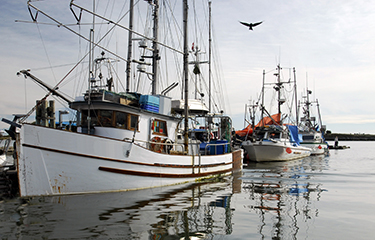Canada unleashes slew of federal funding programs supporting its seafood sector

The Canadian Fish and Seafood Opportunities Fund (CFSOF) has been reopened to help the country’s seafood industry access new consumer markets, especially as the COVID-19 pandemic continues to hurt its economy, Minister of Fisheries, Oceans, and the Canadian Coast Guard Bernadette Jordan announced on 17 June.
The fund, which was initially launched in 2018, is a national cost-sharing federal, provincial, and territorial program aimed at aiding Canada’s seafood sector in addressing new market-access issues and identifying branding opportunities. Ultimately, the program seeks to “maximize the value of Canada's world-class fish and seafood,” the Canadian government affirmed in a press release.
Working with its provincial and territorial partners, the Canadian government is able to offer the fish and seafood sector over CAD 42 million (USD 30.9 million, EUR 27.5 million) in non-repayable support via CFSOF, it said.
"Canada's fish and seafood sector is the driving force behind coastal communities, and an integral part of our country's economy,” Jordan said in an official statement. “The Canadian Fish and Seafood Opportunities Fund is another tool to help this industry adapt to changing consumer demand, build new markets, and maintain a foothold internationally. The new continuous intake process is more straightforward, responsive, and adaptable to industry needs, especially during these uncertain times. Canada has high-quality, world-class seafood and we will continue to find new ways to help promote the industry, their products, and support the women and men in our fisheries."
Applicants now have the chance to submit an Expression of Interest (EOI) to the CFSOF at any time, effectively making the program “more nimble and adaptable to changing circumstances brought on by COVID-19,” the government’s release stated.
“Eligible applicants who meet the principles, criteria, and objectives of the program will then be invited to submit a full proposal following the EOI stage,” officials added.
Seventy percent of CFSOF’s costs are federally assumed, with the remaining 30 percent amassed provincially. The program will fund eligible activities supported by participating provinces and territories, which include British Columbia, Saskatchewan, the Northwest Territories, the Yukon Territory, Ontario, New Brunswick, Prince Edward Island, Nova Scotia, and Newfoundland and Labrador.
The pandemic has also moved the government to take further “decisive action to support Canadians facing hardship” by opening up the application process for the CAD 62.5 million (USD 46.1 million, EUR 41 million) Canadian Seafood Stabilization Fund (CSSF) across the western region of the country starting on 22 June. CSSF will help seafood processors in Western Canada, Quebec, and Atlantic Canada “get through the crisis and prepare for economic recovery, so that their communities can continue to thrive,” according to a separate press release deployed by Jordan’s office.
Jordan and Minister of Economic Development and Official Languages Mélanie Joly said the Western Economic Diversification Canada (WD) will begin accepting applications from Indigenous and non-Indigenous fish and seafood processors next week.
More than CAD 9 million (USD 6.6 million, EUR 5.9 million) in funding from Fisheries and Oceans Canada has been allocated to WD as a means of supporting fish, seafood, and aquaculture processors across Western Canada. Funding will be delivered to fish processors by WD as well as through a partnership agreement with the Investment Agriculture Foundation of BC (IAF) in British Columbia.
“With more than 20 years of experience supporting British Columbia's food producers, IAF will provide high-quality and cost-effective delivery of the CSSF to local processors,” the press release stated. “The CSSF will help fish and seafood processors put in place health and safety measures to help protect workers against COVID-19 and maintain Canadian jobs. It will increase plant capacity to process, store, package, and distribute healthy, high-quality products, and to adapt processes and marketing to suit changing consumer demands. Bolstering the processing sector will be vital to supporting fish and seafood harvesters and strengthening Canada's food supply chain.”
The Fisheries Council of Canada (FCC) and the Canadian Aquaculture Industry Alliance (CAIA) said access to CSSF funding “will help to support the Canadian aquaculture and wild-capture fish and seafood sectors as they weather the COVID-19 pandemic on the front lines,” in a press release.
Canada’s seafood industry operates as an essential service, the organizations noted, and has worked throughout the pandemic to bring consumers the goods they require. But adjusting to the climate of the crisis has been costly, FCC and CAIA explained.
“Adjusting to and adhering to public health guidance has meant increased costs for purchasing PPE, such as face masks and sanitizers for employees, installing physical distancing barriers and supporting mandatory isolation periods. Coupled with a changing marketplace, this has significantly impacted cash flow and created additional cost burdens for many companies,” the groups said.
FCC President Paul Lansbergen said federal support, like that offered with CSSF, is vital to the industry, particularly now.
“As with most essential services, the Canadian fish and seafood industry has had to overcome many hurdles to remain safe and operational during the COVID-19 pandemic,” Lansbergen said. “Federal support is critical to ensuring the industry remains strong to continue to support the food supply chain and lead the way for Canada’s economic recovery.”
“We appreciate the recognition of the importance of the Canadian fish and seafood industry that comes with the launch of the Canadian Seafood Stabilization Fund,” CAIA President and CEO Timothy Kennedy added. “Our industry is a cornerstone of the Canadian economy that supports thousands of jobs in our rural and coastal communities.”
The pandemic has presented considerable obstacles to Canada’s seafood industry, according to Jordan, but the sector continues to bounce back.
"COVID-19 has created real challenges for our fish and seafood processing sector, and they have continued to respond with tenacity and innovation. The Canadian Seafood Stabilization Fund will provide the sector with the support they need to increase their capacity and adapt their strategies to meet the changing demands of the consumer. And we know that by bolstering our processors, we are ensuring consistent buyers for our harvesters and a strong food supply chain, one that includes a consistent stream of Canada's world class fish and seafood," Jordan said.
"As some regions reopen their economy, it is important for us to support small businesses every step of the way now more than ever,” Joly added. “The fish and seafood processors are facing new challenges due to the COVID-19 pandemic and I am happy that Western Economic Diversification Canada is helping them to address the gap in this key sector for the West, which will help communities get through these challenging times. I want Canadians to know that we will be there with you so our regional economies can bounce back even stronger than before. Together we will rise above this crisis."
Applications are also now being accepted for Canada’s federal CAD 50 million (USD 36.8 million, EUR 32.8 million) food surplus purchase program, CBC News reported on 15 June. Announced in May, the program involves federal funds being used to buy surplus food items, including seafood, left uneaten due to mass foodservice and business closures during the pandemic.
The fund money will be allocated in rough thirds, Agriculture and Agri-Food Minister Marie-Claude Bibeau explained to CBC News – one-third will go to horticulture products, another third will be dedicated to meat and poultry products, and the remaining third will be used on fish and seafood.
A primary goal of the program is to direct 10 percent of its purchases to Northern communities known to grapple with food insecurity.
"With restaurants and hotels closed for weeks, many producers were left with extra food they couldn't sell," Canadian Prime Minister Justin Trudeau said, as reported by CBC News.
Fresh or processed and packaged foods in shelf-stable formats are ideal for the program, officials said.
"Priority consideration for surplus commodities that have immediate risk of loss will be determined first," a department release stated. "For example, potatoes and some aquaculture products need immediate processing or will be lost or destroyed."
Photo courtesy of Josef Hanus/Shutterstock






Share